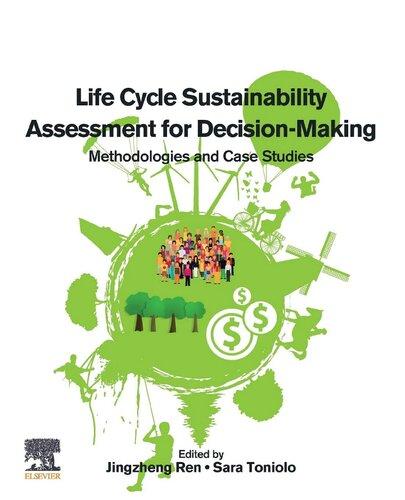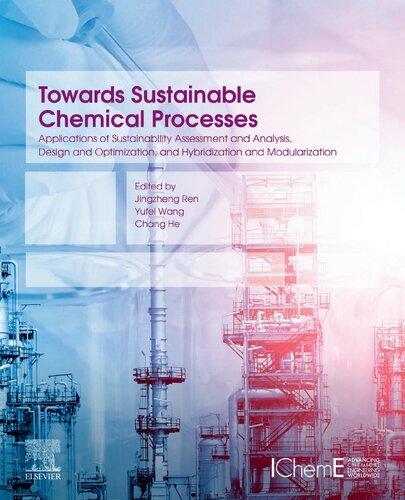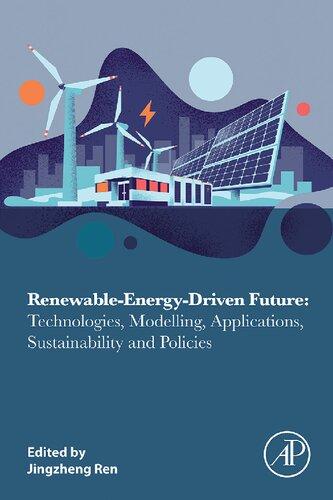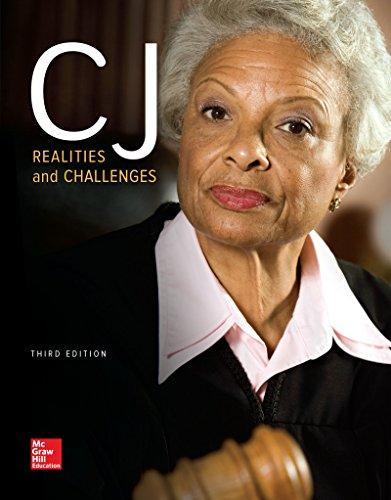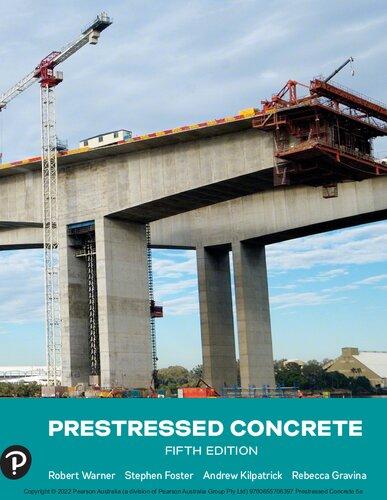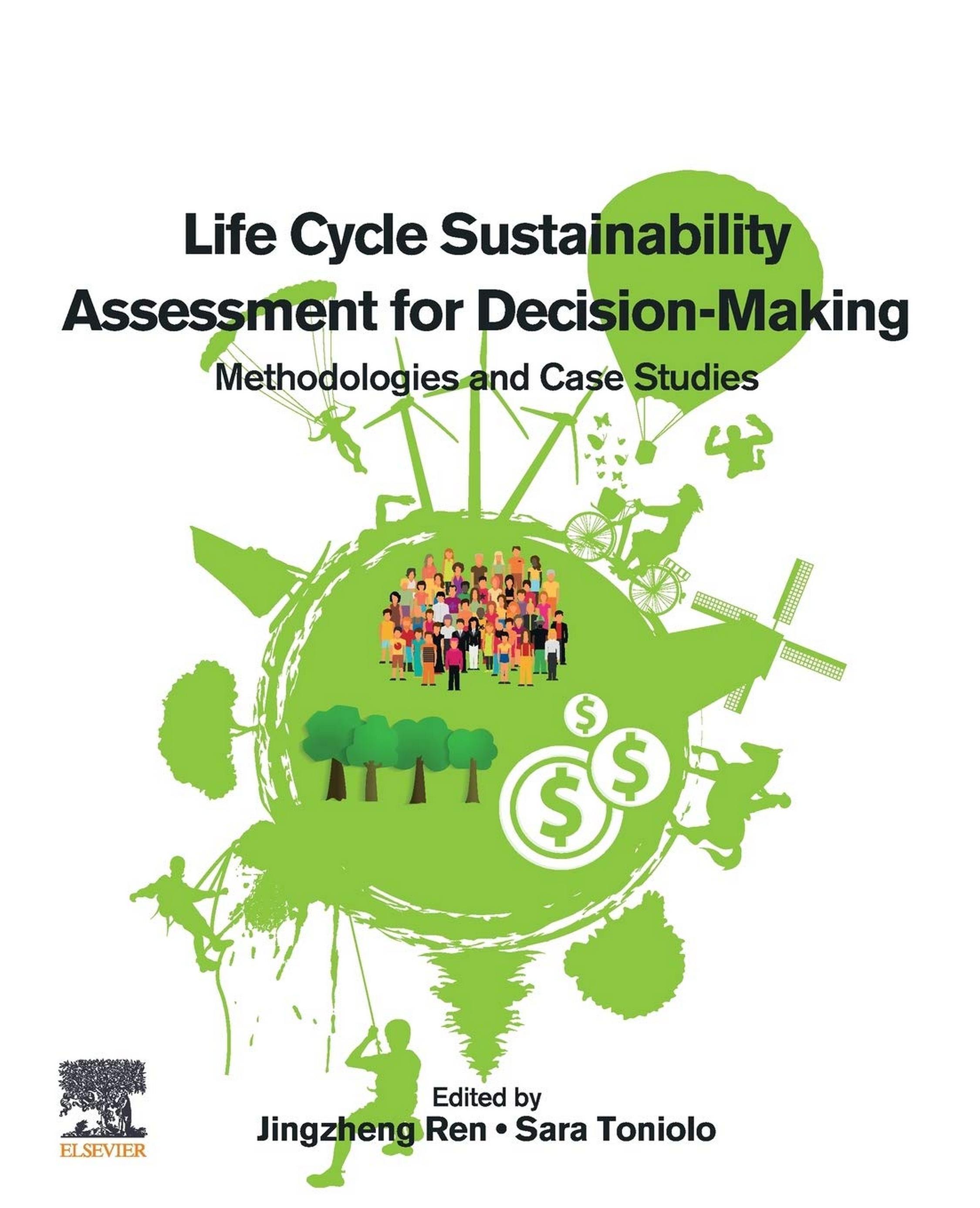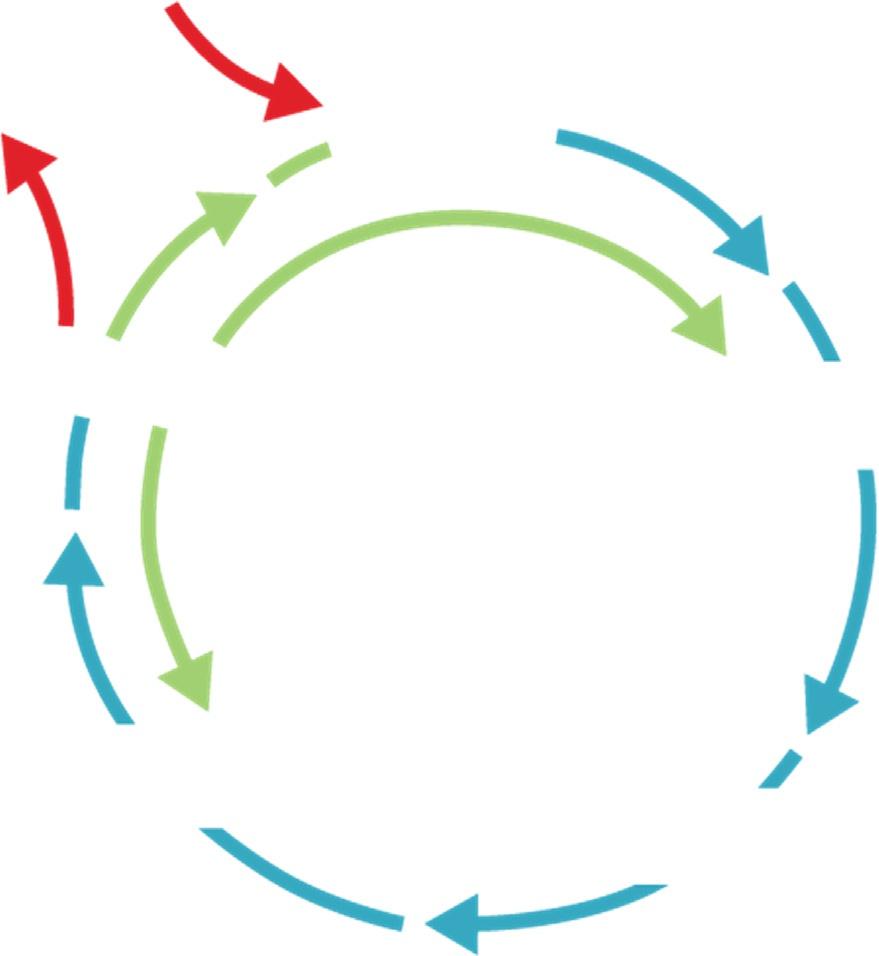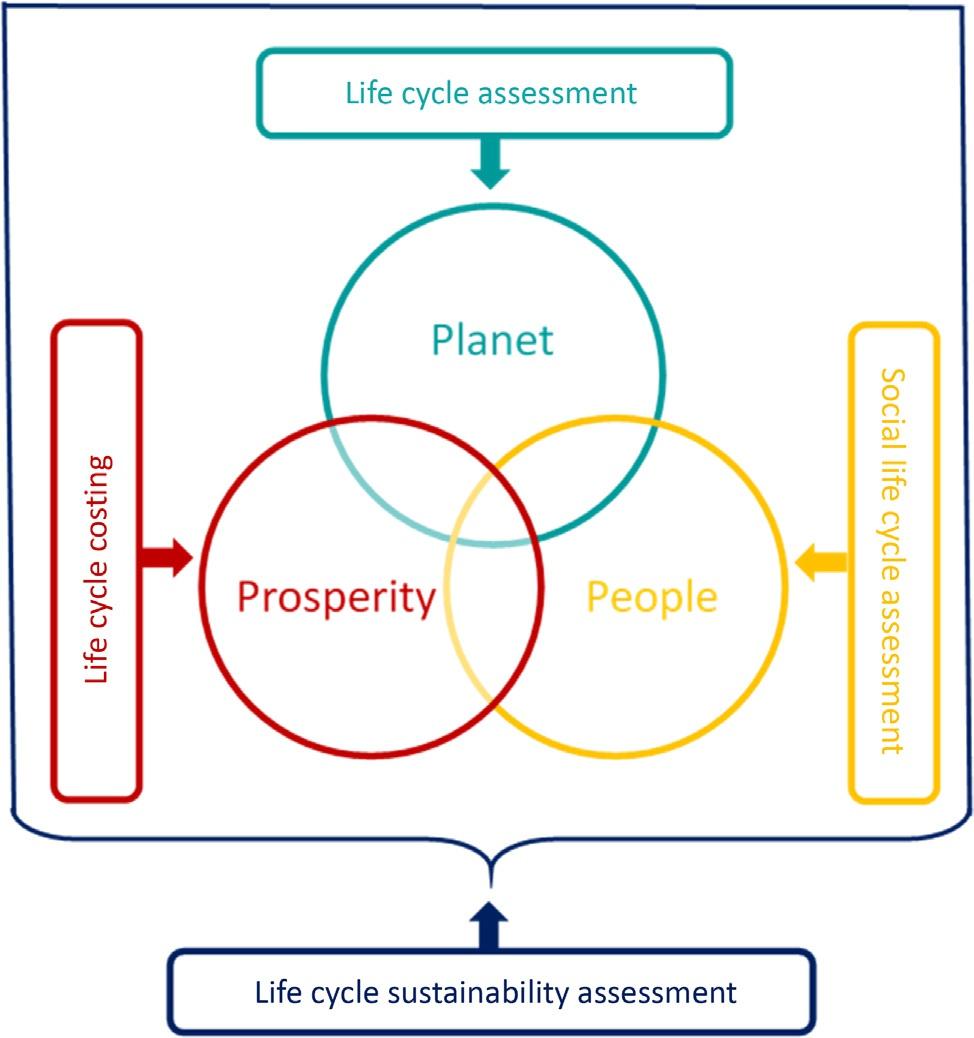LifeCycleSustainabilityAssessmentforDecisionMaking:MethodologiesandCaseStudies1stEdition Jingzheng
Ren(Editor)
https://ebookmass.com/product/life-cycle-sustainabilityassessment-for-decision-making-methodologies-and-casestudies-1st-edition-jingzheng-ren-editor/
Instant digital products (PDF, ePub, MOBI) ready for you
Download now and discover formats that fit your needs...
Biofuels for a More Sustainable Future: Life Cycle Sustainability Assessment and Multi-Criteria Decision Making 1st Edition Jingzheng Ren (Editor)
https://ebookmass.com/product/biofuels-for-a-more-sustainable-futurelife-cycle-sustainability-assessment-and-multi-criteria-decisionmaking-1st-edition-jingzheng-ren-editor/ ebookmass.com
Towards Sustainable Chemical Processes: Applications of Sustainability Assessment and Analysis, Design and Optimization, and Hybridization and Modularization 1st
Edition Jingzheng Ren
https://ebookmass.com/product/towards-sustainable-chemical-processesapplications-of-sustainability-assessment-and-analysis-design-andoptimization-and-hybridization-and-modularization-1st-editionjingzheng-ren/ ebookmass.com
Renewable-Energy-Driven Future: Technologies, Modelling, Applications, Sustainability and Policies Jingzheng Ren (Eds)
https://ebookmass.com/product/renewable-energy-driven-futuretechnologies-modelling-applications-sustainability-and-policiesjingzheng-ren-eds/ ebookmass.com
Petit manuel de survie en médecine intensive-réanimation : 80 procédures en poche Nicolas Lerolle
https://ebookmass.com/product/petit-manuel-de-survie-en-medecineintensive-reanimation-80-procedures-en-poche-nicolas-lerolle/ ebookmass.com
Imperfectly Yours (Half Moon Lake Book 3) A.J. Ranney https://ebookmass.com/product/imperfectly-yours-half-moon-lakebook-3-a-j-ranney/
ebookmass.com
Introduction to Modern Dynamics: Chaos, Networks, Space, and Time 2nd Edition David D. Nolte https://ebookmass.com/product/introduction-to-modern-dynamics-chaosnetworks-space-and-time-2nd-edition-david-d-nolte-2/
ebookmass.com
LooseLeaf for CJ: Realities and Challenges 3rd Edition https://ebookmass.com/product/looseleaf-for-cj-realities-andchallenges-3rd-edition/
ebookmass.com
Prestressed Concrete 5th Edition Warner Foster
https://ebookmass.com/product/prestressed-concrete-5th-edition-warnerfoster/
ebookmass.com
Assassin's Trust: Solar Hearts Book 1 Jenn Allen https://ebookmass.com/product/assassins-trust-solar-heartsbook-1-jenn-allen/
ebookmass.com
Birds For Dummies 2nd Edition Brian L. Speer https://ebookmass.com/product/birds-for-dummies-2nd-edition-brian-lspeer/
ebookmass.com
LIFECYCLESUSTAINABILITY ASSESSMENTFORDECISION-MAKING LIFECYCLESUSTAINABILITY ASSESSMENTFORDECISION-MAKING MethodologiesandCaseStudies Editedby
JINGZHENG REN
TheHongKongPolytechnicUniversity DepartmentofIndustrialandSystemsEngineering HongKongSAR,China
SARA TONIOLO UniversityofPadova DepartmentofIndustrialEngineering Padova,Italy
Elsevier
Radarweg29,POBox211,1000AEAmsterdam,Netherlands
TheBoulevard,LangfordLane,Kidlington,OxfordOX51GB,UnitedKingdom
50HampshireStreet,5thFloor,Cambridge,MA02139,UnitedStates
Copyright©2020ElsevierInc.Allrightsreserved.
Nopartofthispublicationmaybereproducedortransmittedinanyformorbyanymeans,electronicormechanical, includingphotocopying,recording,oranyinformationstorageandretrievalsystem,withoutpermissioninwritingfrom thepublisher.Detailsonhowtoseekpermission,furtherinformationaboutthePublisher’spermissionspoliciesandour arrangementswithorganizationssuchastheCopyrightClearanceCenterandtheCopyrightLicensingAgency,canbe foundatourwebsite: www.elsevier.com/permissions
ThisbookandtheindividualcontributionscontainedinitareprotectedundercopyrightbythePublisher(otherthanas maybenotedherein).
Notices Knowledgeandbestpracticeinthisfieldareconstantlychanging.Asnewresearchandexperiencebroadenour understanding,changesinresearchmethods,professionalpractices,ormedicaltreatmentmaybecomenecessary.
Practitionersandresearchersmustalwaysrelyontheirownexperienceandknowledgeinevaluatingandusingany information,methods,compounds,orexperimentsdescribedherein.Inusingsuchinformationormethodstheyshould bemindfuloftheirownsafetyandthesafetyofothers,includingpartiesforwhomtheyhaveaprofessionalresponsibility.
Tothefullestextentofthelaw,neitherthePublishernortheauthors,contributors,oreditors,assumeanyliabilityfor anyinjuryand/ordamagetopersonsorpropertyasamatterofproductsliability,negligenceorotherwise,orfromanyuse oroperationofanymethods,products,instructions,orideascontainedinthematerialherein.
LibraryofCongressCataloging-in-PublicationData
AcatalogrecordforthisbookisavailablefromtheLibraryofCongress
BritishLibraryCataloguing-in-PublicationData
AcataloguerecordforthisbookisavailablefromtheBritishLibrary
ISBN978-0-12-818355-7
ForinformationonallElsevierpublications visitourwebsiteat https://www.elsevier.com/books-and-journals
Publisher: CandiceJanco
AcquisitionEditor: MarisaLaFleur
EditorialProjectManager: LauraOkidi
ProductionProjectManager: PremKumarKaliamoorthi
CoverDesigner: GregHarris
TypesetbySPiGlobal,India
Contributors AnaCarolinaMaiaAngelo FluminenseFederal University(UFF),VoltaRedonda,Brazil
MartaAvesani EconomyforTheCommon Good–Italy,Bressanone,Italy
EricAwere DepartmentofCivil,Chemicaland ManagementEngineering,Universityof Bologna,Bologna,Italy
AlessandraBonoli DepartmentofCivil, ChemicalandManagementEngineering, UniversityofBologna,Bologna,Italy
DeepjyotiDas CentreforUrbanScienceand Engineering(CUSE),IndianInstituteof TechnologyBombay,Mumbai,India
LichunDong SchoolofChemistryand ChemicalEngineering,ChongqingUniversity, Chongqing,China
FabioGambaro UniversityofPadova, DepartmentofIndustrialEngineering,Padova, Italy
SenGuo SchoolofEconomicsand Management;BeijingKeyLaboratoryofNew EnergyandLow-CarbonDevelopment(North ChinaElectricPowerUniversity),Beijing, China
BeijiaHuang Departmentofenvironmentand architecture,UniversityofShanghaiforScience andTechnology,Shanghai,People’sRepublic ofChina
YingHuang Departmentofenvironmentand architecture,UniversityofShanghaiforScience andTechnology,Shanghai,People’sRepublic ofChina
PradipP.Kalbar CentreforUrbanScienceand Engineering(CUSE);Interdisciplinary ProgrammeinClimateStudies,IndianInstitute ofTechnologyBombay,Mumbai,India
RistoLahdelma DepartmentofMechanical Engineering,AaltoUniversitySchoolof Engineering,Aalto,Finland
JinmingLei Departmentofenvironmentand architecture,UniversityofShanghaiforScience andTechnology,Shanghai,People’sRepublic ofChina
WeichenLi SchoolofChemistryandChemical Engineering,ChongqingUniversity, Chongqing,China
RuojueLin DepartmentofIndustrialand SystemsEngineering,TheHongKong PolytechnicUniversity,HongKongSAR, People’sRepublicofChina
ZhiqiangLiu SchoolofEnergyScienceand Engineering,CentralSouthUniversity, Changsha,People’sRepublicofChina
KeboMa SchoolofEnergyScienceand Engineering,CentralSouthUniversity, Changsha,People’sRepublicofChina
YiMan StateKeyLaboratoryofPulpandPaper Engineering,SouthChinaUniversityof Technology,Guangzhou;Departmentof IndustrialandSystemsEngineering,TheHong KongPolytechnicUniversity,HongKongSAR, People’sRepublicofChina
LinoGuimara ˜ esMarujo FederalUniversityof RiodeJaneiro(UFRJ),RiodeJaneiro,Brazil
AnnaMazzi DepartmentofIndustrial Engineering,UniversityofPadova,Padova, Italy
JingzhengRen TheHongKongPolytechnic University,DepartmentofIndustrialand SystemsEngineering,HongKongSAR,China
SaraToniolo UniversityofPadova,Department ofIndustrialEngineering,Padova,Italy
x Contributors
RobertaChiaraTosato UniversityofPadova, DepartmentofIndustrialEngineering,Padova, Italy
HaichaoWang InstituteofBuilding EnvironmentandFacilityEngineering,School ofCivilEngineering,DalianUniversityof Technology,Dalian,People’sRepublicofChina
DiXu SchoolofChemistryand ChemicalEngineering,Chongqing UniversityofScience&Technology, Chongqing,China
ShengYang SchoolofEnergyScience andEngineering,CentralSouth University,Changsha,People’sRepublicof China
SaraZanni DepartmentofManagement, UniversityofBologna,Bologna,Italy
Introduction.Lifecyclethinking AnnaMazzi
DepartmentofIndustrialEngineering,UniversityofPadova,Padova,Italy
1.1Fromtheenvironmentalconcernstoalifecycleperspective Theissueofenvironmentalsustainabilityisofgreatinteresttoday(UNEP,2011).Theinternationalcommunityencouragescompaniestoadoptcleanerproductionsystemsandtechnologies.Themarketseemstorewardenvironmentallyresponsibleorganizations,andmany companiesaroundtheworldareincreasinglybecominginterestedinenvironmentalissues, introducingthemasstrategicvariablesintheirbusinesses.
However,overtheyears,manyenvironmentalmanagementtoolshaveshownanimportantlimit,thatisthereductionofenvironmentalimpactsofanorganizationoraprocessby allocatingthematothertimes,upstreamordownstreamofthesupplychain,thusincreasing theenvironmentalloadsofothersubjects,suchassuppliers,distributors,customers (O’Rourke,2014).Thisisbecausemanyenvironmentalmanagementtoolsobservetheenvironmentalproblemfromasinglepointofview,theoneofthesingleorganization,whileenvironmentalproblemsaregeneratedbydifferentsubjectsthat,together,contributeina closelyinterconnectedwaytotheoverallenvironmentalimpact.Withaphysicalpointof view,thefootprintofaproductisthesumofthefootprintsofprocessesalongtheproduct supplychainindifferenttimesandgeographicalareas(HoekstraandWiedmann,2014).
Therearemanyexamplesofproblemshifting,wheresolutionsadoptedtoimproveor solveatargetedproblemunintentionallyendupcreatingotherproblemsofenvironmental, economic,orsocialnatureelsewhereforotherstakeholders.Tosolvethisloop,alifecycle approachmustbeadopted.
Emerginginterestinmarketconcernsthegreensupplychainmanagement,whichexplores varioustypesofsupplychainrelationshipsandgovernance,encouragingasustainablemanagementofsuppliersanddistributors(Tsengetal.,2019).Withalifecycleperspective,we considerthetotalityofthesysteminouranalysis,includingtheevaluationoftheproduct’s entirelifecycle,withalong-termtimehorizonandamultidimensionalview.Lifecycle
thinking(LCT)offersthistotality:acomprehensiveanalysisofthetopicitrequires,leadingto solutionsforreducingimpactsinanabsoluteandnotarelativeway.
Asshownin Fig.1.1,aproduct’slifecyclecanbeginwiththeextractionofrawmaterials fromnaturalresourcesintheground,andwithenergygeneration.Materialsandenergyare thenpartofproduction,packaging,distribution,use,maintenance,andeventuallyrecycling, reuse,recovery,orfinaldisposal.Ineachlifecyclestagethereisthepotentialtoreduceresourceconsumptionandimprovetheproduct’sperformance.
Thelifecyclemetaphorisborrowedfromthefieldofbiology.Forexample,thelifecycleof abutterflystartswithanegg,whichburstsandletsacaterpillarout,whichthenturnsintoa pupa,fromwhichabutterflyemerges.Thelattereventuallydiesafterlayingeggsforthecycle toberepeated.Inmuchthesamewayaman-madeobjectstartsitslifecyclebytheharvesting andextractionofresources,followedbyproduction,use,andeventuallymanagementas waste,whichmarkstheendofthelifecycle(Bjørnetal.,2018a).
Tominimizeimpacts,fiveleverscanbeusedinpractice,fromalife-cycleperspective:lifetimeextension,dematerialization,manufacturingefficiency,substitution,andrecovery (OlivettiandCullen,2018).That’swhywetalkaboutLCT.Decisionsmadeconsideringafull lifecycleperspectiveandbroaderimplicationsontheenvironmental,economic,andsocial pillarsofahealthyplanet,allowustoaddressunintendedtrade-offsbetweenthesepillars, andfocusattentiononthekeydriversofchange.Asaresult,progresstowardssustainable developmentisfasterandmoreefficientthanwhendecisionsareisolated(LCI,2017).
Thinkingintermsofthelifecycle,businessesrecognizethateachchoicesetsthestagefor notonlyhowtheproductwilllookandfunction,butalsoforhowitwillimpactthe
FIG.1.1 Atypicalproductlifecyclediagram. LifeCycleInitiative, https://www. lifecycleinitiative.org/starting-life-cycle-thinking/ what-is-life-cycle-thinking/
Natrual resources
Incineration and landfilling
environmentandthecommunityasitismanufactured,used,disposedof,re-used,or recycled.Productscanbedesignedsotheywillhavelessenvironmentalimpactwhenthey aremanufactured,used,anddiscarded.Withalifecycleapproach,companiesareabletocalculatethefulllifecyclecostofthegoodstheypurchase.Thisincludesthepoint-of-purchase priceaswellasthecostsoftransporting,storing,installing,cleaning,operating,repairing, andeventuallydiscardingthosegoods(Hall,2019).
Aswewillexploreinthisvolume,LCTisnotjustamethodologyofanalysis;wecanconsideritaphilosophy,awayofobservingandreflecting,whichleadstoeffectivesolutionsfor overallimprovementofthesustainabilityofproducts,processes,andsystems.Thelifecycle approachpromotesrelevantinnovationsindesigning,producingandusingproductsand services,anditbringsbenefitstoseveralstakeholdersalongtheproductsupplychain;we havesummarizedsomebenefitsin Table1.1.
Tomakechoicesaddressedtolifecycleapproach,designers,manufacturers,andsuppliersneedtoolsforassessingthesustainabilityofalternatives,intermsofpreferability andfeasibility.Themarkettooneedsclearandquantifiedinformation,sothatconsumers andbuyersareabletoevaluatethesustainabilityofalternativeproductsandmakeinformed
TABLE1.1 MainbenefitsoftheadoptionofLCTtothestakeholdersalongtheproductsupplychain.
StakeholdersLCTpromotesLCTavoids
DesignersComprehensive,complete,andconsistentanalysis ofallthefactorsthatcontributetotheimpactofthe product
Designersand manufacturers
Marketingstaff anddesigners
Consumersand market
Wholesupply chainand community
Wholesupply chainand community
Localand international governments
Identificationofsolutionsthatimprovetheoverall performanceofthesystem,whichincludesthe performanceofalltheactorsinthesupplychain
Comparativeevaluationofalternativebusiness solutionsindesign,production,purchasing, distribution,use,andend-of-life
Communicationofclearandconsistentinformation andcreatingawarenessinthemarket
Improvementofentiresystems,notsinglepartsof systems
Choicesforthelongertermandconsideringall relatedenvironmentalandsocialissues
Investmentofeconomicresourcestosupportmore sustainableprojects
partialanalysisoftheenvironmental, economic,andsocialimpactsassociated withsinglephasesofaproduct’slife cycle
Identificationofsolutionsthatfixone environmentalproblembutcause anotherunexpectedorcostly environmentalproblem
Inabilitytocomparedifferentdesign, production,andorganizational alternatives
Communicationofmisleading informationanddisorientationinthe market
Shiftofproblemsfromonelifecycle stagetoanother,fromonegeographic regiontoanother,andfromone environmentalitemtoanother
Shorttermdecisionsthatleadto environmentaldegradation
Wastageofinvestmentsinactionsthat donotimprovetheoverall environmentalperformanceorcreate inefficiencies
purchases.Moreover,localgovernmentsandinternationalinstitutionsmustbeabletohave comprehensiveandrobusttoolstoguidecompaniesandmarketstowardsmoresustainable productionandconsumptionbehavior.Allthesemeasurementneedsfindananswerinthe mostimportantoperationaltoolofLCT:lifecycleassessment(LCA).Thisanalysesthe wholelifecycleofthesystemorproductthatistheobjectofthestudyanditcoversabroad rangeofimpactsforwhichitattemptstoperformaquantitativeassessment(ISO,2006b). LCAisanimportantassessmenttool,asdemonstratedbythecentralroleitisgiveninenvironmentalregulationinmanypartsoftheworldandthestrongincreaseinitsusebycompaniesallovertheworld(HellwegandMila ` iCanals,2014).ThefocusofLCAhasmainly beenontheenvironmentalimpactsalthough,aswewillseeinfollowingsections,bothsocialandeconomicimpactscanbeincludedaswell,withamoreextendedperspective knownassustainabilityassessment.
Duringthelast30years,worldleadershaveexplicitlyrecognizedtheneedtochange unsustainablepatternsofproductionandconsumption,andlifecycleapproachesplaya keyrole.Demandforlifecycletoolshasincreased,primarilythankstonumerousactionspromotedbyinternationalinitiativestosupporttheinclusionoflifecycleapproachesingovernmentsworldwide.Atthesametime,inamarketperspective,bothcompaniesandcustomers aregivingincreasingimportancetoimpactsevaluationofproductsandserviceswithalife cycleperspective.Today,LCTisafundamentalthemethatinvolvesmultiplesectorsand bringstogethertheknowledgeofmanydisciplines.Itscurrentmaturityisduetoaprogressiveevolutionovertheyears,intermsofpractices,methodologies,andpolicies.Thenextsectiondescribesthisevolution.
1.2HistoryofLCT Inthe1930s,economistsbegindiscussingtheunsustainabilityofwelfareinaneconomy thatusesnon-renewableresources(Hotelling,1931).Inthe1960s,attentiontowardsadverse environmentaleffectscausedbyenvironmentalpollutionincreasedandtransparentand science-basedinformationbegintobedemandedbyenvironmentalscientists(Carsol, 1962).Thefirstlifecycleorientedstudymightbetheonepresentedin1963bySmithin theWorldEnergyConferenceanditconcernedtheenergyrequirementsfortheproduction ofchemicalintermediatesandproducts(Boustead,2003).Inthisdecade,thefirstlifecycle studiesintheUnitedStatesandNorthernEuropewereconductedbysomecompaniesin thepackagingsector,inordertodevelopproductionsystemswithenergysavingandemissionsreduction.Thesestudies,carriedoutbylargecompaniesinanisolatedmanner,essentiallyfocusedonthefirm’senvironmentalmanagement,aimedatimprovinginternal processes,withoutinterestincommunicatingtostakeholders(Huntetal.,1992).Early methods,inspiredbymaterialflowaccounting,werefocusedoninventoryingenergyandresourceuse,emissions,andsolidwaste.Withmorecomplexinventories,thefocuswasgraduallyextendedwithatranslationfromphysicalflowsaccountingintoenvironmentalimpact evaluations,ascontributiontoclimatechange,eutrophication,andresourcescarcity(Bjørn etal.,2018b).
Inthe1970s,theconcernsoftheinternationalcommunityregardingenvironmentalproblemscreatedbysomeindustrialactivitiesweregrowing(Meadowsetal.,1972).Scientistsrecognizedresourceconsumptionandwasteproductionasthemaincausesofenvironmental problemsandrecommendedtheclosureofthecyclewithreliability,reparability,andrecyclabilityofproductsattheendoflife(Singer,1970).Atthesametime,inchemicalsandpackagingsectors,theinterestinlifecycleevaluationcontinuedtogrow,focusingonenergy consumption,solidwasteproduction,andairemissions.Intheseyears,thefirstpublic andpeer-reviewedLCAstudywaspublished,commissionedbytheUSEnvironmentalProtectionAgencywiththeaimofinformingregulationonpackaging(USEPA,1974).
Duringthe1980s,thelifecycleapproachevolvedinbothapplicationsandmethodologies, thankstocompanies’interestandthescientificdebate.InEuropeancountries,environmentalattentionrelatedtotheimpactsofmilkpackagingincreasesandLCAstudieswere conductedtocomparealternativepackagingsystemsformilkdistributiontoprivateconsumers.Numerousapplicationsoflifecycleevaluationontechnologiesandsimilarproductswithconflictingresultsrevealedtheneedforthedevelopingofrigorous methodologies.Then,knowledgeandmetricsconcerningcause-effectmechanismsinseveralenvironmentalconcernsweredeepenedbyscientists,todefinerigorousimpactsquantificationandavoidburdenshifting.Intheseyears,thefirstimpactassessmentmethod basedoncriticalvolumeswasintroduced(BUS,1984)andthefirsttwopiecesofcommercial LCAsoftwarewerereleased(Gabiin1989andSimaProin1990).Inlinewiththelifecycle perspective,theUnitedNationspublishedthereport“ourcommonfuture”—amilestonein sustainabledevelopmenthistory—inwhichtheimportanceofrecyclingandrenewableresourcesisdeclared(UN,1987).
Inthe1990s,thelifecycleapproachspread.Thisdecademarksthemostimportantstepsfor theconstructionofLCT.TheUnitedNationsproclaimedtheprinciplesintendedtoguide countriesinfuturesustainabledevelopment(UN,1992).Meanwhile,theterm“lifecycle assessment”iscoined(SETAC,1993),andthefirststandardsarepublishedtoharmonizelife cyclepractices(Favaetal.,1994; ISO,1997).Atthesametime,severallifecycleinventorydatabasesaredevelopedbydifferentinstitutions,andnewimpactassessmentmethodologies aredeveloped,includingcause-effect-damageevaluations(Bjørnetal.,2018b).Duringthis decade,thefirstscientificLCArelatedstudyispublished(Guineeetal.,1993)andanacademicjournalfullydedicatedtotheLCAisborn(Kl € opffer,1996).
Withthebeginningofthenewmillennium,theinternationalcommunitygaveafundamentalroletoLCTforconstructionofasustainablefuture.In2002,attheWorldSummitonSustainableDevelopment,worldleadersrecognizedtheneedtochangetheunsustainable developmentmodelandsubscribecommoncommitmenttoimplementsustainableproductionandconsumption“using,whereappropriate,science-basedapproaches,suchaslifecycle analysis”(UN,2002).Inthesameyear,theUnitedNationsEnvironmentalProtectionandSocietyofEnvironmentalToxicologyandChemistrylaunchtheLifeCycleInitiative,focusedon thedisseminationoflifecyclepracticesallovertheworldand,inparticular,toemerging economies(LCI,2002).IntheEuropeancontext,LCTreceivesastrongpushbytheEuropean IntegratedProductPolicy(IPP),whichsupportspolicyinstrumentslikeenvironmentallabeling,greenpublicpurchase,andintegrationofenvironmentalaspectsintostandardsdevelopment(EC,2003).Moreover,in2005,theEuropeanCommissioncreatestheEuropeanplatform
onLCAtopromotethelifecycleperspectiveatboththeoreticalandoperationallevel(Wolf etal.,2006).Influencingmarketdynamics,theEuropeanpolicycontributestothespreadof lifecycletoolsaroundtheworld.
Inthe21stcentury,methodologicalapproachesofLCTimprove:theinternationalstandardsofLCAarerevised( ISO,2006b,2006c ),andlifecycleperspectiveisgraduallyappliedinseveralsectorsandintegratedwithotherdecisionsupporttoolsinalmostall theareaswhereenvironmental,economic,andsocialconsiderationsareimportant.In theseyears,newframeworksaimingtoextendLCAmethodologytoeconomicandsocial aspectsofsustainabilityareelaborated( Guinee,2016 ),andtheconceptoflifecycleis adoptedinseveralstandardswithdifferentmeaningsandapplications( Toniolo etal.,2019b).
Overthelasttwodecades,impactassessmentmethodshavebeencontinuouslyrefined andseveralmethodologiesupdated;from1999todate,morethan20methodologiesoflife cycleimpactassessmenthavebeenpublishedworldwidebyseveralorganizations (Rosenbaum,2017).Throughmethodologicalconsolidation,lifecycleapproachhasalarge andrapidspread,increasingtherangeofproductsandsystemsanalyzedbybothindustries andgovernments.Theinterestinlifecyclestudieshasincreased,duetothegrowingpublic awarenessofenvironmentalissuesandawidespreadacceptanceofsustainabledevelopment (Houetal.,2015).
Whathappensnextisactuality,whichwillbepresentedinthenextchaptersofthisbook. WhatIwanttoemphasizehere,foranoverview,isthefactthat,fromthe2000s,theincreasein LCTinitiativesaroundtheworldhasgonehandinhandwithincreasingknowledgeofenvironmentalproblems.Ontheonehand,greaterenvironmentalawarenesspushesthescientificcommunitytoimprovemethodsforassessingenvironmentalimpacts,whileontheother, itleadsthemarkettorequestmoreinformationonenvironmentalimpactsassociatedwith products.Thus,avirtuouscircuitisestablished,inwhichlocalgovernmentspromoteLCT toolsonthemarket,consumersarebetterinformedandchoosemoreconsciously,companies investinlifecycleevaluationstoimprovetheirproducts,alsocommunicatingresultstothe market.Towitnessthisvirtuouscircuit,wecanseethat,wherethenumberoflifecycleinitiativesincreases,availableinformationconcerningterritorialenvironmentalqualityincreasesaswell,andindicatorsoftheoverallenvironmentalconditionshowaprogressive improvement(Qian,2016).
Fig.1.2 summarizesthemainevolutionarystepsoftheLCTalongthetimeline.Inthis graph,from1960todate,aprogressiveincreasecharacterizingtheLCTstoryishighlighted infourinterdependentdirections:lifecyclepractices,lifecyclemethods,lifecyclepublications,andlifecyclepolicies.Thefirstlifecyclereasoningisdoneinthe1960s,whenenvironmentaldegradationandlimitedaccesstoresourcesstartbecomingaconcern.Inthefollowing years,LCTtakesshapeandisgraduallyenrichedthroughapplication,harmonization,and dissemination.Lifecyclepracticesalsostartedinthe1960s,asisolatedexperiences,recording astrongboostduringthe1990s,duetothebirthofstandardsandsoftwaretosupportthelife cycleanalyses.Sincethe1990s,governmentinitiativessupportingthelifecycleapproach havemultipliedandscientificliteraturehasexploded.Nowadays,thepanoramaofexperiences,methodologies,andpublicationsconcerningLCTisenormouslyrichandinterdisciplinary,thankstothecomplicityofinternationalpoliciesthatrecommenditsuseinall economicsectors.
1.3LCTandsustainability ThelinkbetweenLCTandsustainabledevelopmentistight.Ontheonehand,sustainabilitypresupposesgivinganoverridingprioritytotheessentialneedscoherentlywithenvironmentallimits,availabletechnologies,andsocio-culturalcontext(UN,1987).Ontheother hand,LCTaimstoconsideralltheimpactsassociatedtoaproductlifecycleinordertoindicatepriorityofinterventionsthataremoreconvenientanduseful(EC,2003).
Sustainabledevelopmentshouldideallyimprovethequalityoflifeforeveryindividual withoutexpendingtheEarth’sresourcesbeyonditscapacity.Withoutafunctioningenvironmentwewillnotbeabletogivefuturegenerationsthesamepossibilitiesforachievingthe levelsofwelfarethatcurrentgenerationsareexperiencing.Researchershaveattemptedto quantifycarryingcapacitiesoftheecosystemthatmustnotbeexceededtomaintainfunctions, aswellasotherecosystemaspectsofinterest.PlanetaryboundariescanbeinterpretedascarryingcapacitiesfortheentireEarthsystemtowardsvariousanthropogenicpressures,suchas greenhousegasesandinterferencewithnutrientcycles(Rockstrometal.,2009).Accordingto estimates,thisexceedancehasalreadyhappenedforfourofthenineproposedplanetary boundaries(Steffenetal.,2015).
Actingtoreducetheimpactontheecosystemis,therefore,necessaryandurgent,butneeds acollectiveeffort.Thejourneytowardssustainabledevelopmentrequiresthatbusinesses, governments,andindividualstakeaction,changingconsumptionandproductionbehaviors, settingpolicies,andchangingpractices.Humanneedsshouldbemetbyproductsandservicesthatareprovidedthroughoptimizedconsumptionandproductionsystemsthatdo notexceedthecapacityoftheecosystem.
FIG.1.2 TimelineofLCTmilestones.
Sustainabilityhasthreedimensions:economy,society,andenvironment.Inthebusiness communitytheterm“triplebottomline”wascoinedtoexplaintheimportanceofachieving sustainability;itimpliesthatindustryhastoexpandthetraditionaleconomicfocustoinclude environmentalandsocialdimensions,inordertocreateamoresustainablebusiness (Elkington,1997).
LCTexpandstheestablishedconceptofcleanerproductiontoincludethecompleteproductlifecycleanditssustainability.Sourcereductioninaproductlifecycleperspectiveisthen equivalenttodesigningwithsustainabilityprinciplesinmind.Ineachlifecyclestagethereis thepotentialtoreduceresourceconsumptionandimprovetheperformanceofproducts;in ordertosucceed,allthestakeholdersintheproductchainhavetobeinvolved,usingacollaborativeapproachandintegratingefforts,withthesamegoal:sustainability.Overall,LCT canpromoteamoresustainablerateofproductionandconsumptionandhelpususeourlimitedfinancialandnaturalresourcesmoreeffectively.Wecanderiveincreasedvaluefrom moneyinvested—suchaswealthcreation,accessibilitytowealth,healthandsafetyconditions,andfewerenvironmentalimpacts—byoptimizingoutputandderivingmorebenefits fromthetime,money,andmaterialsweuse.
ThefullconsistencyofLCTwiththesustainabledevelopmentconceptisthereforeconfirmed.Moreover,recentdevelopmentsofthelifecycleapproachexplicitlyadoptsustainabilityasaframework:internationalpolicieshaveadoptedthe“3Ps”ofsustainability,which standfor“people,planet,andprosperity”,andlinkedLCTtosustainabledevelopment agenda(UN,2002).Meanwhile,thescientificcommunityhasdevelopedadvancedmodels ofLCAmethodology,includingthetriplebottomlineperspective:thus,lifecyclecosting (LCC)andsociallifecycleassessment(SLCA),assecondandthirdpillarsofsustainability, areborn,distinguishingeconomicandsocialimpactsofproductsystemsalongtheirlifecycle. Movingtoamorecomprehensiveassessmentofsustainability,thelifecyclesustainabilityassessment(LCSA)isthemostmodernlifecycle-basedapproachtoevaluatescenariosforsustainablefuturesandpracticalwaystodealwithuncertaintiesandreboundeffectswitha comprehensivevision(Guinee,2016).
Fig.1.3 showsthepossiblelinkbetweenLCTandsustainabledevelopmentthroughthe threepillarsofsustainabilityandthemultidimensionalityofLCT.
In2015,the193memberstatesoftheUnitedNationsadopted17goalsto“endpoverty, protecttheplanet,andensureprosperityforallaspartofanewsustainabledevelopment agenda”by2030(UN,2015a,b).Tomeetthegoalsandtargets,sustainabilitymustgainstrong prominenceindecisionmakingsupportforalleconomicactorsalongthesupplychainwho areresponsibleforcreatingsolutionsforthefuture:allcompaniesthatdesign,create,supply, andbuy,allconsumersthatchoose,buy,use,anddispose,alllocalgovernmentsandinstitutionsthatregulate,control,andsupport.
Tosupportsustainabledecisions,fromsmall-tolarge-scaleperspective,themarketneeds comprehensiveandrobusttolls.Toavoidtheoften-seenphenomenonofproblemshifting, wherethesolutiontoaproblemcreatesseveralnewproblems,decisionsmustbetakenwith asystemsperspective.LCTaimstofacilitatetheapplicationoflifecycleknowledgeinthe globalsustainabledevelopmentagendainordertoachievethesustainabledevelopment goalsfasterandmoreefficiently(Wulfetal.,2018).Throughthelifecycleapproach,werecognizehowourchoicesinfluencewhathappensateachphase,sowecanbalancetrade-offs ineconomicandenvironmentalconsequencescausedbyourchoices.
FIG.1.3 PossiblelinkbetweenLCTandsustainabledevelopmentinthetriplebottomline perspective.
FurtherchallengesofLCTinachievingsustainabledevelopmentgoalsaredescribedin Section1.5.
1.4ToolsandactionsinLCT Alifecycleapproachidentifiesopportunitiesandrisksofaproductortechnology,from rawmaterialstodisposal,named“fromcradletograve”.Consumers,companies,and governmentsusethesevariouslifecycleapproachesformanydifferentpurposes,from day-to-dayshopping,toselectingsuppliers,engineeringanewproductdesign,ordevelopinganewprocess,project,orbusiness.Citizens,businesses,andgovernmentsarefinding waystopromoteLCTandtobalancetheimpactsoftheirchoices.Alifecycleapproachappliedtocommunityplanninganddevelopmentcanleadtofewerenvironmentalimpacts frommaterialsused,constructionpractices,andwastemanagement,aswellasenergyand waterusedbypeoplelivingandworkinginthecommunity.
Tosupportdiffusionofthelifecycleapproachamongbusinesscommunitiesandlocalgovernments,thescientificcommunityandinternationalorganizationspromotenumerousinitiatives,whichwecansummarizeintwotypologies:
•Lifecycletools,whichincludestandardsandguidelinestoassistresearchers,practitioners, andcompaniesinapplyingtheprinciplesoflifecycleapproachtoproducts,processes,and projects;
•Lifecycleactions,whichincludedisseminatingandsupportinginitiativesaimedat spreadingthelifecycleapproachininternationalandlocalpolicies,aswellasfosteringthe understandinganduseoflifecycletoolsbetweencompaniesandconsumers.
Fig.1.4 showsthemaininitiativesinLCT,aslifecycletoolsandactions.Thefollowing chaptersofthisbookwilldescribethem.Hereabriefsummaryisgiven.
1.4.1Lifecycleassessment LCArepresents“thebestframeworkforassessingthepotentialenvironmentalimpactsof products”(EC,2003).Itisamethodtoassessquantitativelytheenvironmentalimpactsof goodsandprocessesfromcradletograve.LCAmodelscause-effectrelationshipsintheenvironmentandthushelpstounderstandtheenvironmentalconsequencesofhumanactions.
ToconductanLCAstudyforproductsandservicesinmanyeconomicactivitiesaround theworld,practitionersaresupportedbytwointernationalstandards:theISO14040andthe ISO14044,respectivelycontaininggeneralprinciplesandspecificrequirementsforanLCA (ISO,2006b,2006c).FourfeaturesofLCAmakeitacompleteandrobusttooltosupportcompaniesandmarketsinsustainabilitycommitments:ittakesalifecycleperspective,coversa broadrangeofenvironmentalissues,isquantitative,andisscience-based(Bjørnetal.,2018a).
LCAisanimportantdecision-supporttoolthat,amongotherfunctions,allowscompanies tobenchmarkandoptimizetheenvironmentalperformanceofproductsorforauthoritiesto designpoliciesforsustainableconsumptionandproduction.ManyLCAstudiesare conductedtosupportcorporateinternaldecision-making,suchasforecodesignofproducts, processoptimizations,supply-chainmanagement,andmarketingandstrategicdecisions (HellwegandMila ` iCanals,2014).Recentinitiativesgoastepfurther,byaimingtogeneralize thelifecycleapproachinallconsumptionsectors,throughharmonizationoflifecycle-based
FIG.1.4 ToolsandactionsinLCT.
informationonavarietyofimpactcategoriestobedisplayedinproductlabeling(Toniolo etal.,2019a).
1.4.2Lifecyclecosting,sociallifecycleassessment,andlifecyclesustainability assessment
Indesigning,manufacturing,delivering,using,recovering,anddisposingproducts,variousrequirementshavetobeintegratedwithenvironmentalaspects:feasibility,convenience, security,acceptability;oftenconflictingrequirementshavetobefulfilled.Therefore,tosupportcomplexdecisions,multidimensionalapproachesarenecessary(Mazzietal.,2016).Both scientistsandcompanieshaverecentlymovedinthisdirection,extendingtheLCAmodelto economicandsocialdimensions.
Tobehonest,theconceptofenvironmentalLCCpredatesLCA:lifecyclecostreferstoall costsassociatedwiththesysteminadefinedtemporallifecycle(BlanchardandFabrycky, 1998).Recently,theLCAcommunityhascomeclosertothisconceptwiththeaimofintegratingfinancialdataandcostinformationwithenvironmentallifecyclemetrics.Then,LCChas becometheacronymofthetoolwhich,consistentlywithLCAmodel,acrosstheproduct’slife cycle,includesallcostsbornebydifferentactorswithdifferentperspectivesandatdifferent times(HunkelerandRebitzer,2003).AcodeofpracticeforLCChasbeenpublishedbythe SocietyofEnvironmentalToxicologyandChemistryforevaluatingdecisionswithconsistent systemsboundariesasacomponentofproductsustainabilityassessments(Swarretal.,2011). Inacompanyperspective,LCCisakeytoolforsustainablebusiness,becauseithelpsingivingtherightsignaloneconomicimplicationsofsustainableproductionforthedecisionmakeraswellasgivingprioritytothemostcost-effectiveenvironmentalimprovements (HannoufandAssefa,2016).
TheSLCAisamethodologicalapproachaimedatevaluatingsocialandsocioeconomicaspectsofproductsandtheirpotentialpositiveandnegativeimpactsalongtheirlifecycle.Socialimpactsarethosethatmayaffectstakeholdersalongtheproductlifecycleandmaybe linkedtocompanybehavior,socioeconomicprocesses,andimpactsonsocialcapital (Benoı ˆtandMazijn,2009).Fromacompanyperspective,oneofthemainaddedvaluesof SLCAisthepossibilitytospendtheresultsofsocialevaluationonthemarket.Thiscould beachieved,forexample,bymeansofasociallabel(Zamagnietal.,2011).
SLCAisstillnotwidespreadbecauseitsuffersfromadoubledifficulty:definitionandapplication.SLCAencompassesunquantifiableissuesofethicsandvalueswithholisticandpersonnelperspectives,suchasactivecitizenship,well-beingandhappiness,preserving socioculturaldiversity,andmeetingbasicneeds(Mattiodaetal.,2015).RecenteffortstofacilitatethepracticalityofSLCAaredirectedtosolvethelackofavailabledataandthedifficultytoevaluateimmaterialimpactswithundefinedcause-effectrelationships (Weidema,2018).
Concerninglifecyclesustainabilityassessment(LCSA),definitionsarenotyetcarvedin stone.TwomaindefinitionsofLCSAexist.KlopfferandRenner(Klopffer,2008)propose tocalculatetheLCSAasthesumofthethreestudies:LCA,LCC,andSLCA;thus,LCSA broadensLCAmethodologyincludingeconomicandsocialaspectsinthelifecycleevaluation. Guineeetal.(2011) startfromthepreviousdefinitionandaddtwodimensionsof
evaluation,relatedtotheexternalcontestoforganizations:technologicalconditionsand economicstate.
Movingfromtheorytopractice,theconceptoflifecyclesustainabilityispresentedinseveralstandardswithdifferentmeaningsandapplications.Evenifallsustainabilitydimensions arestandardizedbyinternationalcommunity,environmentstillremainsthemostconsidered oneinalifecycleapproach(Tonioloetal.,2019b).
1.4.3PartialLCAs:Carbonfootprintandwaterfootprint Overthelast50years,somecriticalenvironmentalissueshaveparticularlyworriedtheinternationalcommunity:theemissionofgreenhousegasesisthemaincauseofglobalclimate change;thescarcityoffreshwateravailabilityiscriticalforhealthylivesandahealthyplanet; theenergyconsumptioncloselylinkedtotheavailabilityofnonrenewableresourcesisadangerousbrakeoneconomicdevelopmentandathreattopoliticalandsocialworldbalance;and increasinglanduseandfossilfuelcombustionareleadingtoenhancedlossesofreactivenitrogentotheenvironment.Attentiontospecificenvironmentalissueshasledthescientific communitytodevelopimpactassessmenttoolsabletogointodepthonindividualenvironmentalissues.Sincethe1980s,inordertoknowenvironmentalimpactsrelatedtogreenhouse gasesemission,waterconsumption,energysustainability,andnitrogenvariation,among companies,newmetricneedshaveemerged.Tomeetthemarket’sneedsandprovidebusinessesandconsumerswithrigorousassessmentmethods,newstandardshavebeen publishedforthecalculationoftheso-called“partialLCAs.”
Tocalculatethecarbonfootprint(CF)ofaproductorservice,theISO14067specifiesmethodologyandrequirementstomeasuretheemissionsofgreenhousegasesininputandoutput ofaproduct’slifecycle,andtheassociatedenvironmentalimpactsonclimatechange(ISO, 2018b).ThisresultcorrespondstothepartialresultofLCArelatedtothelifecycleimpactcategoryindicator“globalwarmingpotential”;therefore,CFisatypicalcaseof“partialLCA.”
Tosupportorganizationsinassessingtheenvironmentalprofileofwaterfootprint(WF) consumptionanddegradation,theISO14046indicatesmethodologyandcharacteristicsthat needtobetakenintoconsiderationwhenassessingtheWFofaproductfromalifecycleperspective(ISO,2014).WFisdefinedasametricthatquantifiesthepotentialenvironmentalimpactsrelatedtowater.Itincludesidentificationandevaluationoftheimpactsrelatedto consumptivewateruse(e.g.,scarcityandavailability)andrelatedtodegradativewater use(e.g.,eutrophicationandacidification).TheWFgivesaprofileoftheimpactcategoryresultsthatcanbereportedinastandalonestudyoraspartofamorecomprehensiveLCA study(Mazzietal.,2014).
TheenvironmentalprofileobtainedbythesepartialLCAshassomeadvantagesbutalso limitations.Fromascientificperspective,partialLCAslackacomprehensiveenvironmental view,becausetheyobserveinputsandoutputsoftheproductlifecyclewithapartialview which,despitebeingimportant,isstillrelative.Ontheotherhand,LCtoolssuchasCFand WFmaybemoredetailedthanacompleteLCAinexaminingspecificenvironmentalproblemsbecause,byfocusingonsingleenvironmentalparameters,theyinvestigatethoroughly thecause-effect-damagerelationsofasingleimpactcategory.
Fromamarketperspective,alongsupplychainsandtowardsconsumers,thedemandfor informationconcerningenvironmentalfootprintincreases,anditguideseffortsin ecoinnovation,ecomanagement,andecolabeling.Companiesandconsumersundoubtedly prefersyntheticandimmediateevaluationandcommunicationtools,althoughintaking CForWFastheoneandonlyyardstick,onehastofacelife-threateningtrade-offs (Finkbeiner,2009).
FutureperspectivestodeveloppartialLCAsdoexist;theselifecycletoolscandeepenthe analysisofsingleenvironmentalproblems,enrichingenvironmentalmodelsthatsupportlife cycleimpactassessmentwithadhocquantificationandregionalization(Bulleetal.,2019).
1.4.4Ecolabeling LCA,originallydevelopedtobeusedasadecisionsupporttoolforenvironmentalmanagement,nowhasseveralrelatedapplicationssuchasexternalcommunicationthroughenvironmentallabelsanddeclarations.AsISOclassified,threetypologiesofenvironmental labelsexist:typeI,II,andIII;foreachofthemwecanrefertoadhocstandards,formeasuring andcommunicatingtheenvironmentalperformanceofproducts:ISO14024(ISO,2018a),ISO 14021(ISO,2016),andISO14025(ISO,2006a),respectively.
Inrecentyears,themarketdemandforenvironmentalproductdeclarations,suchastype IIIenvironmentallabels,hasincreased,aswellasthenumberofprogramoperators(Toniolo etal.,2019a).Atthesametime,intheEuropeanmarket,theEuropeanCommissionlaunched theProductEnvironmentalFootprint(EC,2013),amulticriteriamethodtocalculatetheenvironmentalprofileofproductswithalifecycleperspective;itisanapplicabletool supportingexternalcommunicationorpublicprocurementtenderrequirements.
Thisgrowingnumberofdifferentenvironmentalproductdeclarationschemeswithdifferentrequirementscausesconfusioninthemarketanddisorientationinpurchasingdecisions; consequently,anefforttomakelabelsmorereproducible,comparable,andverifiable,willbe muchappreciatedbythemarket(DelBorghietal.,2019).
1.4.5Lifecycleinitiative HostedbytheUN,thankstothecommoncommitmentsoftheUnitedNationsEnvironmentalProtectionandSocietyofEnvironmentalToxicologyandChemistry,theLifeCycle Initiative(LCI)istheinterfacebetweenusersandexpertsoflifecycleapproaches(LCI, 2017).LCIprovidesaglobalforumtoensureascience-basedandconsensus-buildingprocess tosupportdecisionstowardsthesharedvisionofsustainabilityasapublicgood.Itdelivers authoritativeopiniononsoundtoolsandapproachesbyengagingmulti-stakeholderpartnership,includinggovernments,privateandpublicorganizations,scientists,scholars,andcivil society.
TheLCIisapublic-private,multistakeholderpartnershipenablingtheglobaluseofcrediblelifecycleknowledgebyprivateandpublicdecisionmakers.Itfacilitatestheapplicationof principlesandtoolsofLCTinlocalgovernmentsandmarkets.ThemissionofLCIhastwo
maindirections:toimprovedecisionsthatneedassessmentandcomparisonofproducts, technologies,lifestyles,andeconomy-widechoices,andtobuildconsensusonenvironmental,social,andeconomiclifecycleknowledge,withinventorydata,impactassessment methods,andindicators.Topursuethesecommitments,LCIestablishesperiodicactionprogramsandverifiestheresults;throughnumerousinitiativesanditswebsite,itprovidespublicationsandcommunicationsandpromotescollaborationbetweenstakeholdersaround theworld.
1.4.6Integratedproductpolicy IPPisaEuropeaninitiative,developedbytheDirectorate-GeneralforEnvironment,aimed atreducingtheenvironmentalburdenofproductsandservicesthroughouttheirlifecycles. Thiscanbeachievedusingatoolboxofpolicyinstrumentsthatmakemarketsmoresustainablethroughgreeningboththedemandside(consumption)andthesupplyside(productdevelopment)(EC,2003).ItisanattemptbytheEuropeanCommissiontocreateconditionsin whichenvironment-friendlyproducts,orthosewithareducedimpactontheenvironment, willgainwidespreadacceptanceamongtheEuropeanUnionMemberStatesandtheEuropeanmarket.
IPP,withinenvironmentallyadvancedcountriesinEurope,ispartofagrowingtrendtowardsproduct-orientedenvironmentalpolicies.Itseekstominimizeallenvironmentaldegradationscausedbyproductsthroughouttheentirelifecycle,bylookingatallphasesofits lifecycleandactingwhereitismosteffective.Toachievethischallenginggoalandsucceedin interveningondifferentsubjectswithoftencontradictoryinterests,IPPincludesseveralmeasuressuchaseconomicinstruments,substancebans,voluntaryagreements,environmental labeling,andproductdesignguidelines.
1.4.7EuropeanPlatformonLCA TheEuropeanPlatformonLCArepresentstheEuropeananswertobusinessandpolicy needsforsocialandenvironmentalassessmentsofsupplychainsandend-of-lifewastemanagement.ItwasbornprimarilytosupporttheEuropeanIPP,toincreasetheavailabilityof quality-assuredlifecycledata( JRC,2006).TheEuropeanPlatformonLCAisimplemented bytheJointResearchCentre,incollaborationwiththeEuropeanDirectorate-GeneralEnvironment,tosupportbusinessandgovernmentneedsforavailability,interoperability,and qualityoflifecycledataandstudies,supplyingguidelinesspanningfrommethodological aspectstocharacterizationmodels.Formorethan10years,thisplatformhaselaborated frameworksandguidelinestosupporttheLCApractitioners,withmethodologicalandpracticalimprovementsofinventorydatabasesandimpactassessmentmethods(Sanfelix etal.,2013).
1.5EmergingtrendsinLCT ManyauthorsinrecentyearshavehighlighteddevelopmentprospectsofLCTtools. Recallingsomeofthemhere,ratherthantobeexhaustive,Iwanttostimulateonceagain thediscussion.
SeveralrecentpapersemphasizethedirectionsinwhichLCTtoolsmustevolvetomeet emergingmarketdemands.Tocontinuebuildingagreaterdemandisfundamentaltoredirect resourcesofcompaniesandgovernmentstowardsalifecyclestrategy.Thestartingpoint mustremainunderstanding,identifying,andmanagingrisks,opportunities,andtrade-offs associatedwithproducts,technologies,andservicesovertheirwholelifecycle(Fava,2016). Unlikethemoretraditionalsite-specificapproachestoenvironmentalprotection,sustainabilitystrategieshaveimplicationsthatextendacrossaproduct’slifecycleandrequireengaging stakeholderswhocaninfluencetheabilitytomanufactureandsellproductsaroundthe world.Next,researchdevelopments,bothinscientificandbusinesscommunities,willinvestigatetheadaptationofcollaborativesupplychainsolutionswithsustainabilityissues, throughapplicationofLCTinsuppliermanagement(O’Rourke,2014).Sustainablepublic procurementandsustainablebuildingswilllikelycreatethemostimmediatedemandforlife cycleapproachesinthemarket,witha“domino”effect.Whetherandhowthefinancialsector incorporateslifecycleapproachesintotheirsustainabilityratingschemescouldbeafurther demandthatwillpushthediffusionoflifecycleapproaches.
Thegrowingknowledgeofenvironmentalproblemsandcause-effectmechanismsatlocal andgloballeveldeterminesemergingneedsfortheassessmentofenvironmentalimpacts. Thattranslatesintoeffortstoimprovelifecycleinventories,enrichingavailablelocaland globaldataandinformation,andintegratingthelifecycleimpactassessmentmodelstoincludemoredetailedandsite-specificcause-effectsrelationships.Atthesametime,theusers oflifecycletoolsneedtohaveavailablelifecycleevaluationswithintelligentresults,which includeuncertaintiesandknowledgelimitations( Jolliet,2006).
Climatechangestressesterrestrialecosystems,increasingseasons’length,andaltering communitycomposition;thesestressesenhanceproductivityandwater-useefficiency,but alsoleadtoincreasedmortalityanddisturbancesfromwildfires,insects,andextrememeteorologicalevents.Next,changesoflifecycletoolsmustconsiderthelinkofclimateprocesses withEarthsystemmodels,includingvulnerability-adaptationdescriptorssuchasatmosphericandoceanicstates,landuse,habitatloss,wateravailability,wildfirerisk,airquality, crops,andfishery(BonanandDoney,2018).Forfuture-orienteddecisions,environmentalassessmentlifecyclemethodologiesmustprogressivelyincludeindirectimpacts,relatedland use,waterconsumption,airemissions,acidification,eutrophication,andsoon.Forthispurpose,thetraditionalLCAmodelmustbecombinedwithotherdisciplines,suchasgeneral andpartialequilibriummodelsfromeconomicsciences(HellwegandMila ` iCanals,2014).
Untilnow,thesocialandethicaldimensionsofsustainabilityhavenotbeengiventhesame attentionwithinthebusinesscommunity,sincethebenefitsarelesstangible.However,examplesofpositivelinksexistbetweenenvironmentalimprovementsandhealthandsafetyimprovementsintheworkplace.Now,ageneraltrendshowscompanies’andgovernmental policiestobemoresensibletowardsintegratedmanagementsystemsinordertotakeinto considerationalsohealthandsafetyissues,aswellasothersocialaspects(Zamagni,2012).
1.Introduction.Lifecyclethinking
EmergingapproachescombiningLCT,triplebottomline,andsustainabledevelopment goalsprovethatsomedifficultiesremaintosolve.FocusingonLCSA,itsapplicationrequires properandquantitativedataandmethodsforLCSAindicators,includingdealingwithvalue choicesandsubjectivityandtheguidelinesforexternalcommunication(Guinee,2016).
References Benoı ˆt,C.,Mazijn,B.(Eds.),2009.GuidelinesforSocialLifeCycleAssessmentofProducts.SocialandSocio-Economic LCAGuidelinesComplementingEnvironmentalLCAandLifeCycleCosting,ContributingtotheFullAssessmentofGoodsandServiceswithintheContextofSustainableDevelopment.UNEP/SETACLifeCycleInitiative, Paris,France.
Bjørn,A.,Owsianiak,M.,Molin,C.,Laurent,A.,2018a.MaincharacteristicsofLCA.In:Hauschild,M.Z., Rosenbaum,R.K.,Olsen,S.I.(Eds.),LifeCycleAssessment:TheoryandPractice.Springer,ISBN:978-3-31956474-6,pp.9–16.Chapter2.
Bjørn,A.,Owsianiak,M.,Molin,C.,Hauschild,M.Z.,2018b.LCAhistory.In:Hauschild,M.Z.,Rosenbaum,R.K., Olsen,S.I.(Eds.),LifeCycleAssessment:TheoryandPractice.Springer,Cham,Switzerland,ISBN:978-3-31956474-6,pp.17–30.Chapter3.
Blanchard,B.,Fabrycky,W.J.,1998.SystemsEngineeringandAnalysis.PrenticeHall,UpperSaddleRiver,NJ. Bonan,G.B.,Doney,S.C.,2018.Climate,ecosystems,andplanetaryfutures:Thechallengetopredictlifeinearthsystemmodels.Science.359(6375),eaam8328. https://doi.org/10.1126/science.aam8328
Boustead,I.,2003.Chapter3:Polymersandenergy.In:Andrady,A.L.(Ed.),PlasticsandtheEnvironment.Wiley Interscience,Hoboken,NJ,ISBN:0-471-09520-6,pp.123–135.
Bulle,C.,Margni,M.,Patouillard,L.,Boulay,A.M.,Bourgault,G.,DeBruille,V.,Cao,V.,Hauschild,M., Henderson,A.,Humbert,S.,Kashef-Haghighi,S.,Kounina,A.,Laurent,A.,Levasseur,A.,Liard,G., Rosenbaum,R.K.,Roy,P.O.,Shaked,S.,Fantke,P.,Jolliet,O.,2019.IMPACTWorld+:agloballyregionalizedlife cycleimpactassessmentmethod.Int.J.LifeCycleAssess. https://doi.org/10.1007/s11367-019-01583-0 BUS,1984.BundesamtfurUmweltschutz: OkobilanzenvonPackstoffen(Life-cycleassessmentofpackaging materials)(inGerman).In:SchriftenreiheUmweltschutz.Bern,Switzerland,p.vol.24. Carsol,R.,1962.SilentSpring.HoughtonMifflinHarcourt,Boston,MA. DelBorghi,A.,Moreschi,L.,Gallo,M.,2019.Communicationthroughecolabels:howdiscrepanciesbetweenthe EUPEFandEPDschemescouldaffectoutcomeconsistency.Int.J.LifeCycleAssess. https://doi.org/10.1007/ s11367-019-01609-7
EC,2003.IntegratedProductPolicy.BuildingonEnvironmentalLife-CycleThinking.CommunicationfromtheCommissiontotheCouncilandtheEuropeanParliamentCOM/2003/0302final. https://eur-lex.europa.eu/legalcontent/EN/TXT/PDF/?uri¼CELEX:52003DC0302&from¼EN.(Accessed19May2019).
EC,2013.ANNEXII:Productenvironmentalfootprint(PEF)guidetocommissionrecommendationontheuseof commonmethodstomeasureandcommunicatethelifecycleenvironmentalperformanceofproductsandorganisations.In:EuropeanCommission(Ed.),OfficialJournaloftheEuropeanUnion. Elkington,J.,1997.CannibalswithForks:TheTripleBottomLineof21stCenturyBusiness.Capstone,NewSociety. Fava,J.,Denison,R.,Jones,B.,Curran,M.A.,Vigon,B.,Selke,S.,Barnum,J.(Eds.),1994.SETACWorkshopReport: ATechnicalFrameworkforLife-CycleAssessment.SmugglersNotch,Vermont,August18–231990.SETACPress. Fava,J.A.,2016.Willthenext10yearsbeasproductiveinadvancinglifecycleapproachesasthelast15years?Int.J. LifeCycleAssess.11(SpecialIssue1),6–8. https://doi.org/10.1065/lca2006.04.003 Finkbeiner,M.,2009.Carbonfootprinting—opportunitiesandthreats.Int.J.LifeCycleAssess.14,91–94. https://doi. org/10.1007/s11367-009-0064-x
Guinee,J.B.,UdodeHaes,H.A.,Huppes,G.,1993.Quantitativelifecycleassessmentofproducts:1.Goaldefinition andinventory.2.Classification,valuationandimprovementanalysis.J.Clean.Prod.1(1),3–13. https://doi.org/ 10.1016/0959-6526(93)90027-9
Guinee,J.B.,Heijungs,R.,Huppes,G.,Zamagni,A.,Masoni,P.,Buonamici,R.,Ekvall,T.,Rydberg,T.,2011.Lifecycle assessment:past,present,andfuture.Environ.Sci.Technol.45(1),90–96. https://doi.org/10.1021/es101316v
Guinee,J.,2016.Lifecyclesustainabilityassessment:whatisitandwhatareitschallenges?In:Clift,R.,Druckman,A. (Eds.),TakingStockofIndustrialEcology.Springer,Cham,ISBN:978-3-319-20570-0,pp.45–68.
Hall,M.R.,2019.Thesustainabilityprice:expandingenvironmentallifecyclecostingtoincludethecostsofpoverty andclimatechange.Int.J.LifeCycleAssess.24,223–236. https://doi.org/10.1007/s11367-018-1520-2
Hannouf,M.,Assefa,G.,2016.Commentsontherelevanceoflifecyclecostinginsustainabilityassessmentofproduct systems.Int.J.LifeCycleAssess.21(7),1059–1062. https://doi.org/10.1007/s11367-016-1136-3
Hellweg,S.,Mila ` iCanals,L.,2014.Emergingapproaches,challengesandopportunitiesinlifecycleassessment. Science344(6188),1109–1113. https://doi.org/10.1126/science.1248361
Hoekstra,A.Y.,Wiedmann,T.O.,2014.Humanity’sunsustainableenvironmentalfootprint.Science344(6188), 1114–1117. https://doi.org/10.1126/science.1248365.
Hotelling,H.,1931.Theeconomicsofexhaustibleresources.J.Polit.Econ.39(2),137–175. https://doi.org/ 10.1086/254195.
Hou,Q.,Mao,G.,Zhao,L.,Du,H.,Zuo,J.,2015.Mappingthescientificresearchonlifecycleassessment:a bibliometricanalysis.Int.J.LifeCycleAssess.20(4),541–555. https://doi.org/10.1007/s11367-015-0846-2.
Hunkeler,D.,Rebitzer,G.,2003.Lifecyclecosting–pavingtheroadtosustainabledevelopment?Int.J.LifeCycleAssess.8(2),109–110.
Hunt,R.G.,Sellers,J.D.,Franklin,W.E.,1992.Resourceandenvironmentalprofileanalysis:alifecycleenvironmental assessmentforproductsandprocedures.Environ.ImpactAssess.Rev.12(12),245–269. https://doi.org/ 10.1016/0195-9255(92)90020-X
ISO,1997.ISO14040:1997—EnvironmentalManagement—LifeCycleAssessment—PrinciplesandFramework.InternationalOrganizationforStandardization,Geneva,Switzerland.
ISO,2006a.ISO14025:2006EnvironmentalLabelsandDeclarations—TypeIIIEnvironmentalDeclarations— PrinciplesandProcedures.InternationalOrganizationforStandardization,Geneva,Switzerland.
ISO,2006b.ISO14040:2006EnvironmentalManagement—LifeCycleAssessment—PrinciplesandFramework.InternationalOrganizationforStandardization,Geneva,Switzerland.
ISO,2006c.ISO14044:2006EnvironmentalManagement—LifeCycleAssessment—RequirementsandGuidelines.InternationalOrganizationforStandardization,Geneva,Switzerland.
ISO,2014.ISO14046:2014EnvironmentalManagement—WaterFootprint—Principles,RequirementsandGuidelines. InternationalOrganizationforStandardization,Geneva,Switzerland.
ISO,2016.ISO14021:2016EnvironmentalLabelsandDeclarations—Self-DeclaredEnvironmentalClaims(TypeIIEnvironmentalLabelling).InternationalOrganizationforStandardization,Geneva,Switzerland.
ISO,2018a.ISO14024:2018EnvironmentalLabelsandDeclarations—TypeIEnvironmentalLabelling—Principles andProcedures.InternationalOrganizationforStandardization,Geneva,Switzerland.
ISO,2018b.ISO14067:2018GreenhouseGases—CarbonFootprintofProducts—RequirementsandGuidelinesfor Quantification.InternationalOrganizationforStandardization,Geneva,Switzerland.
Jolliet,O.,2006.EmergenceandFutureofLifeCycleImpactAssessment:Goodsciencecomesfromgoodpeople.Int.J. LifeCycleAssess.11(specialissue1),9–10. https://doi.org/10.1065/lca2006.04.004.
JRC,2006.SupportingBusinessandPolicyMakinginEuropeWithReferenceDataandRecommendedMethods onLifeCycleAssessment(LCA)forBetterPracticeinLCAUseandInterpretation.JointResearchCenter, EuropeanCommission,Varese,Italy. http://ec.europa.eu/environment/ipp/pdf/flyer_lca_0511.pdf.(Accessed 19May2019).
Klopffer,W.,1996.Editorial.Int.J.LifeCycleAssess.1(1),3. https://link.springer.com/content/pdf/10.1007% 2FBF02978623.pdf.(Accessed19May2019).
Klopffer,W.,2008.Lifecyclesustainabilityassessmentofproducts.Int.J.LifeCycleAssess.13(2),89–95. https://doi. org/10.1065/lca2008.02.376
LCI,2002.PhaseI(2002–2006):CreatingaCommunity.LifeCycleInitiative. https://www.lifecycleinitiative.org/ activities/phase-i/.(Accessed19May2019).
LCI,2017.LifeCycleInitiative2017–2022StrategyDocument.LifeCycleInitiative.
Mazzi,A.,Manzardo,A.,Scipioni,A.,2014.Chapter4-waterfootprinttosupportenvironmentalmanagement:An overview.In:Salomone,R.,Saija,G.(Eds.),PathwaystoEnvironmentalSustainability.MethodologiesandExperiences.Springer,Switzerland.
Mazzi,A.,Toniolo,S.,Manzardo,A.,Ren,J.,Scipioni,A.,2016.Exploringthedirectionontheenvironmentaland businessperformancerelationshipatthefirmlevel.Lessonsfromaliteraturereview.Sustainability8,1200. https://doi.org/10.3390/su8111200
Mattioda,R.A.,Mazzi,A.,Canciglieri,O.,Scipioni,A.,2015.Determiningtheprincipalreferencesofthesociallife cycleassessmentofproducts.Int.J.LifeCycleAssess.(8),1155–1165. https://doi.org/10.1007/s11367-0150873-z
Meadows,D.H.,Meadows,D.L.,Randers,J.,Behrens,W.W.,1972.TheLimitstoGrowth.PotomacAssociates-UniverseBooks,ISBN:0-87663-165-0.
Olivetti,E.A.,Cullen,J.M.,2018.Towardasustainablematerialssystem.Science360(6396),1396–1398. https://doi. org/10.1126/science.aat6821
O’Rourke,D.,2014.Thescienceofsustainablesupplychains.Science344(6188),1124–1127. https://doi.org/10.1126/ science.1248526
Qian,G.,2016.WhatcausesmoreLCAresearch—subjectivevalues,objectiveproblems,orscientifictraditions?Int.J. LifeCycleAssess.21(7),1049–1058. https://doi.org/10.1007/s11367-016-1111-z.
Rockstr € om,J.,Steffen,W.,Noone,K.,Persson,A ˚ .,Chapin,F.S.,Lambin,E.,Lenton,T.M.,Scheffer,M.,Folke,C., Schellnhuber,H.J.,Nykvist,B.,deWit,C.A.,Hughes,T.,derLeeuw,S.,Rodhe,H.,S € orlin,H.,Snyder,P.K., Costanza,R.,Svedin,U.,Falkenmark,M.,Karlberg,L.,Corell,R.W.,Fabry,V.J.,Hansen,J.,Walker,B., Liverman,D.,Richardson,K.,Crutzen,P.,Foley,J.,2009.Planetaryboundaries:exploringthesafeoperating spaceforhumanity.Ecol.Soc.14(2),32. http://www.ecologyandsociety.org/vol14/iss2/art32/.(Accessed19 May2019).
Rosenbaum,R.K.,2017.Selectionofimpactcategories,categoryindicatorsandcharacterisationmodelsingoaland scopedefinition.In:Curran,M.A.(Ed.),LCACompendium—TheCompleteWorldofLifeCycleAssessment— GoalandScopeDefinitioninLifeCycleAssessment.Springer,Dordrecht,pp.63–122. https://doi.org/ 10.1007/978-94-024-0855-3
Sanfelix,J.,Mathieux,F.,delaRu ´ a,C.,Wolf,M.A.,Chomkhamsri,K.,2013.TheenhancedLCAresourcesdirectory: Atoolaimedatimprovinglifecyclethinkingpractices.Int.J.LifeCycleAssess.18,273–277. https://doi.org/ 10.1007/s11367-012-0468-x
SETAC,1993.GuidelinesforLife-CycleAssessment:A“CodeofPractice”(fromtheSETACWorkshopHeldat Sesimbra,Portugal,31March–3April1993).SETAC,Brussels/Pensacola. Singer,S.F.,1970.Reducingtheenvironmentalimpactofpopulationgrowth.Science169(3951),1233. https://doi. org/10.1126/science.169.3951.1233
Steffen,W.,Richardson,K.,Rockstrom,J.,Cornell,S.E.,Fetzer,I.,Bennett,E.M.,Biggs,R.,Carpenter,S.R.,de Vries,W.,deWit,C.A.,Folke,C.,Gerten,D.,Heinke,J.,Mace,G.M.,Persson,L.M.,Ramanathan,V., Reyers,B.,Sorlin,S.,2015.Planetaryboundaries:guidinghumandevelopmentonachangingplanet.Science 347(6223),1259855. https://doi.org/10.1126/science.1259855
Swarr,T.E.,Hunkeler,D.,Kl € opffer,W.,Pesonen,H.L.,Ciroth,A.,Brent,A.C.,Pagan,R.,2011.EnvironmentalLife CycleCosting:ACodeofPractice.SocietyofEnvironmentalChemistryandToxicology(SETAC),Pensacola. Toniolo,S.,Mazzi,A.,Simonetto,M.,Zuliani,F.,Scipioni,A.,2019a.Mappingdiffusionofenvironmentalproduct declarationsreleasedbyEuropeanprogramoperators.SustainableProd.Cons.17,85–94. https://doi.org/ 10.1016/j.spc.2018.09.004.
Toniolo,S.,Mazzi,A.,Mazzarotto,G.,Scipioni,A.,2019b.Internationalstandardswithalifecycleperspective:which dimensionofsustainabilityisaddressed?Int.J.LifeCycleAssess. https://doi.org/10.1007/s11367-019-01606-w. Tseng,M.L.,Islam,M.S.,Karia,N.,Fauzi,F.A.,Afrin,S.,2019.Aliteraturereviewongreensupplychainmanagement: trendsandfuturechallenges.Resour.Conserv.Recycl.141,145–162. https://doi.org/10.1016/j. resconrec.2018.10.009.
UN,1987.ReportoftheWorldCommissiononEnvironmentandDevelopment:OurCommonFuture.UnitedNations,NewYork. https://sustainabledevelopment.un.org/content/documents/5987our-common-future.pdf (Accessed19May2019).
UN,1992.ReportoftheUnitedNationsConferenceonEnvironmentandDevelopment.AnnexI—RioDeclarationon EnvironmentandDevelopment.UnitedNations,RiodeJaneiro.
UN,2002.PlanofImplementationoftheWorldSummitonSustainableDevelopment.UnitedNations.UNDocuments,A/CONF.199/20, http://www.un-documents.net/jburgpln.htm.(Accessed19May2019).
UN,2015a.TheMillenniumDevelopmentGoalsReport.UnitedNations,NewYork.
UN,2015b.TransformingourWorld:The2030AgendaforSustainableDevelopment,a/RES/70/1.UnitedNations, NewYork.
UNEP,2011.TowardsaGreenEconomy:PathwaystoSustainableDevelopmentandPovertyEradication.Nairobi, Kenya,UnitedNationsEnvironmentProgram,ISBN:978-92-807-3143-9. USEPA,1974.ResourceandEnvironmentalProfileAnalysisofNineBeverageContainerAlternatives.FinalReport. EPA/530/SW-91c,U.S.EnvironmentalProtectionAgency,Washington,USA.
Weidema,B.P.,2018.Thesocialfootprint—apracticalapproachtocomprehensiveandconsistentsocialLCA.Int.J. LifeCycleAssess.23(3),700–709. https://doi.org/10.1007/s11367-016-1172-z
Wolf,M.A.,Pennington,D.,Bersani,R.,2006.TheEuropeanPlatformonLCA—towardsgoodpracticeinLCAanda systemofhigh-qualityLCIdatabasesforindustryandgovernment.In:InternationalConferenceonGreenand SustainableInnovation2006.JRC,EnergyManagementandConservationCenter,p.116. http://publications. jrc.ec.europa.eu/repository/handle/JRC36718.(Accessed19May2019).
Wulf,C.,Werker,J.,Zapp,P.,Schreiber,A.,Schl € or,H.,Kuckshinrichs,W.,2018.Sustainabledevelopmentgoalsasa guidelineforIndicatorselectioninlifecyclesustainabilityassessment.Procedia69,59–65. https://doi.org/ 10.1016/j.procir.2017.11.144.
Zamagni,A.,Amerighi,O.,Buttol,P.,2011.StrengthsorbiasinsocialLCA?Int.J.LifeCycleAssess.16(7),596–598. https://doi.org/10.1007/s11367-011-0309-3.
Zamagni,A.,2012.Lifecyclesustainabilityassessment.Int.J.LifeCycleAssess.17(4),373–376. https://doi.org/ 10.1007/s11367-012-0389-8.
Sustainability,sustainable development,andbusiness sustainability MartaAvesani
EconomyforTheCommonGood–Italy,Bressanone,Italy
2.1Sustainabilityandsustainabledevelopment: Mainconceptsandapproaches
Theworldisnowadaysunsustainable(WBCSD,2010; UNNewsCentre,2012). KPMG International(2012) identified10“mega-forces”(climatechange,energyandfuel,material resourcescarcity,waterscarcity,populationgrowth,wealth,urbanization,foodsecurity, ecosystemdecline,anddeforestation)thatchallengeourworldand,ifnotadequatelyand urgentlytackled,couldunderminehumanlifeandtheenvironmentinthenext20years. OxfamInternational(2014) affirmsthatsocialinequalitiesarerising,despitethedevelopment ofemergingcountries.TheIntergovernmentalPanelforClimateChange(IPCC,2015)states thatextremeeventsrelatedtoclimatechangeareincreasinginfrequency.Theseareonly someexamplesofthedangershumanityisfacingtodayandwhichwillhavetodealwith inthefuture.
Sustainabilityhasprobablybecomethemostusedapproachtodevelopmentinthelast threedecades,enteringthediscourseinnumerousdisciplinesatalllevels.Researchers, politicalinstitutionsatalllevels,businesses,andcivilsocietyorganizations,allgivetheir owninterpretationtotheconcept.Asaconsequence,sustainabledevelopmenthasseveral meaningsanddefinitionsandthereisnoagreementaboutit(Mebratu,1998; Giddings etal.,2002).Thischapterwillonlyprovidethereaderwithabriefoverviewontheorigins andmaincharacteristicsoftheconcept.

